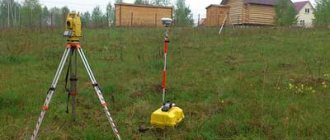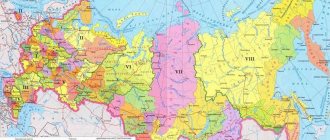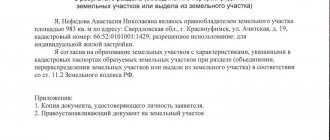Home / Real estate / Land / Size of land
Back
Published: 11/16/2017
Reading time: 14 min
0
693
The actual sizes of land plots for gardening and vegetable gardening partnerships are determined and formed by local authorities on the basis of the provisions of general federal laws.
- How are sizes adjusted? Regulatory acts
Sizes of land plots
The law sets a limit on the size of plots that can be obtained from the municipality. The limitation is provided for the minimum and maximum values. It depends on the purpose of the land plot.
Important! Restrictions are established only when plots are provided free of charge or for long-term lease. If a citizen wishes to acquire land ownership, the size of the plots is not limited.
Development indicators that affect the maximum plot size:
- minimum and maximum building height or number of floors;
- percentage of development (calculated based on the built-up area to the total area of the land plot);
- the amount of setbacks that are not subject to construction.
How are sizes adjusted?
Regulation of issues related to the maximum and smallest available areas of land allocated to citizens for the purposes of gardening is reflected in the Codes of the Russian Federation - Town Planning and Land.
In addition, within the scope of its competence, the size of the land provided is also regulated by legislative acts and regulatory documents of the constituent entities of the Russian Federation and municipalities.
Depending on the region, the limit values may vary or even be absent.
Standards are used to rationalize the provision of land plots to certain categories of applicants (individuals, legal entities, families, etc.) for use or for purchase for certain purposes.
Regulatory acts
Regulation of the areas of land suitable for provision for the purposes of gardening and vegetable farming is carried out by the following regulations:
Article No. 14 of the Land Code of the Russian Federation (hereinafter referred to as the Land Code). Defines, in particular, the following:
- land transferred free of charge to an NPO in the form of an SNT or other partnership cannot exceed in area the amount of area determined under the category of property for public use and directly the amount of territories allocated for gardening needs. That is, in total – the land for the plots plus the general territory;
- land that is allocated to a gardening or vegetable garden category partnership is calculated based on the amount of the maximum allowable allocation of land per person (other accounting unit) within the legal conditions and the number of participants in the target non-profit organization, plus additional boundaries of up to 25% of the territory of plots for public needs. That is, the maximum value is determined by the number of owners, the established limit of land per owner, plus public land.
The Town Planning Code of Russia also contains an indication of the maximum categories of values within land plots; it also includes provisions regarding the boundaries of plots and the conditions of permitted development.
With regard to development, urban planning standards affect the maximum (
primarily, minimum) values of areas that can be allocated as a separate plot of land with the possibility of development (including dacha construction).
The code regulating urban planning standards also defines the functionality of the PZZ (rules regarding the development and use of land areas). The Code states that the issue of regulating maximum areas for various categories of use is within the competence of local authorities - at the level of regulations, provisions and PZZ adopted by the constituent entities of the Russian Federation and municipalities. formations.
That is, the specific values of the maximum and minimum limits for possible areas allocated for use or acquisition by citizens, including gardening and vegetable garden non-profit organizations, are determined by local authorities and their provisions can be referred to for clarification.
The effect of Article 14 of the Land Code of the Russian Federation will last until January 1. 2021, after which the document will lose force due to the provisions of Federal Law No. 217 of June 29, 2021.
The conditions for the provision of land subject to urban planning regulations are regulated by these regulations. The conditions for the provision of land, which are not within the purview of urban planning regulations, are regulated by the Land Code and other laws of the Russian Federation.
You will be interested to know the answer to the question: can a husband receive maternity benefits? Got sick on vacation? Do you want to apply for sick leave? Read here how to do it correctly.
You can find out the competent advice and information you need on calculating maternity benefits in our article.
What are PPPs for?
Regulatory regulation of the size of land plots is fixed:
- in the Land Code;
- in the Town Planning Code;
- in PPZ (land use and development rules).
Violation of the standards for the maximum size of plots entails the impossibility of their state registration. Thus, the owner does not have ownership of the object.
Land use and development rules are established by local authorities. They include town planning regulations, which regulate the maximum size of plots and the types of permitted land use.
The limit value refers to mandatory standards. Directions for use:
- formation of a new site;
- allocation of a site from state and municipal lands;
- division of private land.
The area does not meet established standards
The law prohibits state registration of an object if it does not comply with established standards. The value cannot be less or more than a certain PPP for a specific type of land plot and the required method of use.
In this case, not only the actual size of the plot matters, but also the size of the excess part. The maximum excess value cannot exceed 10%. If the excess part is more than the established standard, then the citizen will have to buy the rest from the municipality.
Owners pay for the maintenance of the land plot, which is part of the common property of the house
Management organizations are responsible for the maintenance of the land plot if it is formed and is part of the common property. The common property of the residents of the house is a plot with the following characteristics:
- it has been formed (clause 4, part 1, article 36 of the RF Housing Code);
- its boundaries and size are determined in accordance with the requirements of the law (clause “e”, clause 2 of RF PP No. 491);
- State cadastral registration was carried out in its respect (Part 5, Article 16 of the Federal Law of December 29, 2004 No. 189-FZ).
The land plot is transferred into ownership free of charge from the moment of its formation. Until this time, it is the property of a public legal entity (clause 67 of the resolution of the Plenum of the Supreme Court of the Russian Federation, Supreme Arbitration Court of the Russian Federation dated April 29, 2010 No. 10/22).
Elena Shereshovets noted that if the boundaries of the land plot adjacent to the apartment building are not established, the plot itself is not specified, there is no plan diagram, the management authority is not obliged to maintain such a territory. Citizens and legal entities are responsible only for the condition of the plots that are in their ownership or possession.
In this case, authorities or a court may oblige owners to maintain the territory adjacent to their land plots - on the basis of federal law or an agreement. This conclusion was made by the Supreme Court of the Russian Federation in paragraph 7 of the Review of Judicial Practice No. 4 (2018). Find out more from the online seminar materials below the article.
Can the local self-government not form a plot for an apartment building in the absence of money?
To which areas do the limits not apply?
The regulations apply to certain plots of land. The law provides a list of lands to which the rules do not apply:
- purchased from municipal or state property;
- intended for the location of objects of state and municipal enterprises.
The main condition is the intended use of the allotment. List of objects that can be located in such areas:
- car roads;
- municipal power supply, water supply, heating facilities;
- federal and regional transport and communication facilities;
- federal and regional electrical systems.
In addition, the law establishes the concept of indivisible plots. Indivisible lands are understood as lands whose area is less than the established minimum limit in a particular municipality.
Limit sizes of plots in various municipalities
Since responsibility for setting the maximum size of land plots rests with local authorities, depending on the municipality, the value can vary significantly.
The establishment of different standards is due to the following reasons:
- ratio of vacant and occupied sites;
- population density;
- number of inhabitants;
- prospects and directions of land use;
- the demand for plots of land for a specific purpose and others.
Differences in standards for different types of land
The PPZ of various municipalities sets the minimum and maximum size of land plots, depending on:
- from the purpose of the site;
- standards for one family;
- norms for one subsidiary farm.
PPZ established by the municipality must not contradict the norms of federal and regional land legislation.
For residential construction
Standards for individual housing construction are established taking into account:
- building rules;
- site operation rules;
- building codes and regulations.
The importance of the minimum size of a building plot is determined by the danger to residents of neighboring lands from the constructed facility. Therefore, a residential building cannot be built closer than a certain border. It depends on the materials used in construction. The border can be from 8 to 15 meters from the border of the plot.
In order for all requirements for the placement of objects to be met, the value must be formed taking into account the data:
- on the economic development of the municipality;
- about consumer demand for such objects;
- about the number of plots;
- about the area where objects are located.
Before receiving a plot, it is advisable to clarify the standards with the local administration.
For household farming and gardening
Land limits for private household plots vary depending on the purpose. Standards are established separately for summer cottage construction and for farming.
On average, according to federal law, the minimum size is 6 acres. The maximum should not exceed 0.15 hectares.
Important! If a municipality experiences a shortage of this type of land, then the standards may decrease.
Agricultural plots
Standards for agricultural land are established in order to avoid misuse of the plot.
The minimum size is set at the discretion of the municipality. The maximum value is limited by federal law. It cannot exceed 10% of all agricultural lands of the municipality.
Responsibility for determining the minimum and maximum size of plots rests with local authorities. However, standards must be formed based on the norms of federal legislation. They vary depending on the purpose of the land.
Your rating of the article
What to consider when choosing the area of a land plot
Cash investments for improvement
When drawing up an estimate, take into account not only the cost of the object and the construction of the cottage, but also the prices for the construction of outbuildings, a bathhouse, a swimming pool, the purchase of landscape design objects, and paving paths.
The total area of the plot directly affects how much the owner will spend annually on its maintenance. A large house requires significant costs for maintaining utility networks, a spacious territory requires clearing snow, maintaining a tidy lawn, and caring for plants.
Purpose of the site
The size of the plot for the construction of a private house must be sufficient to accommodate all additional functional areas. Building a house from scratch without a garden, vegetable garden, or recreation areas does not require a large area.
If the area will be used as a summer cottage, usually 6-8 acres are enough: they can accommodate a vegetable garden with greenhouses and a small holiday house.
House size
Even before purchasing, you should accurately understand the size of the house on the site. When choosing the size of a building, evaluate the number of residents, requirements for the size and location of residential and common areas.
The maximum size of a house on a plot is not limited. When choosing the area and location, it is important to consider the boundary lines on the property plan.
Additional buildings
It is necessary to calculate in advance the dimensions of each building on the land plot: bathhouse, garage, workshop, building for equipment and other objects.
Landscape
Think about what else will be located on the territory. It can be:
- gardening area;
- landscaped recreation area in eco-style;
- artificial pond;
- other improvement objects.
If you don’t want to spend money on landscaping the site, a small property near the forest will do.
Form of land plot
It is important to take into account not only the size of the plot for the construction of a residential building, but also the ratio of its overall dimensions. The small width and twice the length of a rectangular plot of land will make you think about proper zoning of space. Difficulties will also arise when purchasing an object of non-standard shape.









